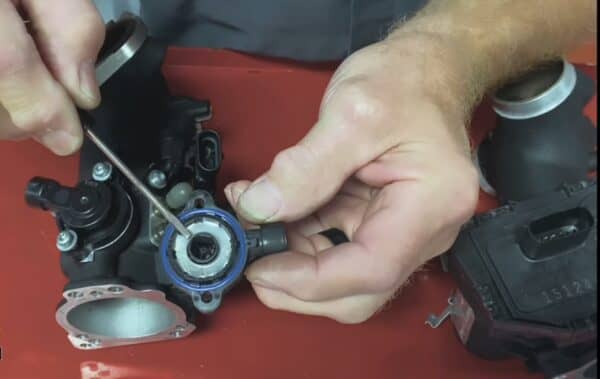
Welcome to the world of Harley-Davidson motorcycles, where power, freedom, and the open road converge to create an exhilarating riding experience like no other.
As every Harley enthusiast knows, these iconic machines are not just motorcycles; they are a way of life. However, like any sophisticated piece of machinery,
Harley-Davidson bikes utilize a range of electronic systems to ensure optimal performance and efficiency.
Among these essential systems is the Throttle Position Sensor (TPS), a crucial component responsible for precisely controlling the throttle’s opening and closing.
Over time, due to various factors such as wear and tear or changes in the bike’s configuration, the TPS may need to be reset to maintain peak performance.
In this article, I will explain Harley-Davidson TPS reset, providing you with valuable insights and step-by-step instructions to keep your iron horse running at its best.
Let’s dive into:
How to Reset Harley Davidson Throttle Position Sensor?
Before going into the reset you must be aware of the throttle position sensor.
What is the Harley Davidson Throttle Position Sensor?
The Harley Davidson Throttle Position Sensor (TPS) is a crucial component in the engine management system of Harley Davidson motorcycles.
It plays a fundamental role in determining the throttle position, which is the extent to which the rider’s throttle grip is twisted.
The TPS sends real-time feedback to the motorcycle’s electronic control unit (ECU) about the throttle’s position, allowing the ECU to adjust the fuel injection and ignition timing accordingly.
This precise data ensures optimal engine performance, fuel efficiency, and emissions control.
By continuously monitoring the throttle position, the TPS helps deliver smooth and responsive power delivery to enhance the overall riding experience.
If the TPS malfunctions or sends inaccurate data, it can lead to poor engine performance, rough idling, or reduced fuel efficiency, underscoring its criticality in the Harley Davidson motorcycle’s overall functionality.
Regular maintenance and calibration of the TPS are essential to ensure peak performance and reliability of the motorcycle.
How to Reset Harley Davidson Throttle Position Sensor?
Before doing anything with your TPS I will recommend you to consult a Harley Davidson certified mechanic. Because the throttle position sensor is very sensitive and if you are not much aware of the hardware of Harley Davidson then it may lead you to a more critical situation.
To reset your throttle position sensor follow these steps:
Preparation
Ensure your motorcycle is turned off and the key is removed from the ignition. Safety is essential when working with any part of your bike.
Locate the TPS

The throttle position sensor is usually located on or near the throttle body. On some Harley Davidson models, it might be integrated into the throttle body itself.
Check for Wiring Issues
Before attempting a reset, inspect the wiring and connections of the TPS for any signs of damage or corrosion. Ensure all connections are secure.
Because it may be possible that your TPS did not require a reset. Maybe some wiring malfunction occurs and causes problems with your throttle body.
TPS Adjustment Procedure
The TPS reset procedure might involve adjusting the TPS to a specific voltage value. This value will depend on the model and year of your motorcycle. The service manual should provide the correct voltage range.
Be careful and check the exact voltage required for your throttle position sensor.
Then adjust the same voltage of your throttle position sensor.
Resetting the TPS
In some cases, you can reset the TPS by turning the ignition to the “ON” position without starting the engine. Slowly twist the throttle to the full-open position and then release it. Repeat this process two or three times.
Clearing Error Codes
If you have any error codes related to the TPS, you might need to clear them using a diagnostic tool or by disconnecting the battery for a few minutes.
Recheck and Test
After completing the reset, turn off the ignition, and then turn it back on. Start the engine and allow it to idle for a few minutes. Verify that the throttle response is smooth and stable.
Need Attention
Remember, the TPS is a critical component that affects your motorcycle’s performance, so if you are unsure about the process or face any issues, it’s best to seek professional help from a Harley Davidson dealership or a qualified mechanic.
Please note that the procedures and specifications mentioned here might not apply to all Harley Davidson models, so always refer to the official service manual for your specific motorcycle.
What are the symptoms of throttle position sensor failure?
Throttle position sensor (TPS) failure in a Harley Davidson can lead to various issues with the engine’s performance and overall riding experience. Let’s go through the step-by-step symptoms of TPS failure in a Harley Davidson:
Poor Throttle Response
One of the initial signs of a failing TPS is a noticeable delay or lack of response when you twist the throttle. The bike might hesitate before accelerating, or the power delivery may feel uneven and sluggish.
Idle Problems
As the TPS plays a critical role in maintaining the correct idle speed, a faulty sensor can cause irregular idling. The engine might idle too high or too low, which will lead to rough running or stalling at a standstill.
Surging or Jerking
When riding at a consistent speed, a defective TPS can cause the engine to surge or jerk unexpectedly. This can be particularly problematic at cruising speeds, where a smooth ride is essential for comfort and safety.
Fluctuating RPM
The RPM (revolutions per minute) reading on the bike’s tachometer may fluctuate erratically when the TPS is failing. This can occur even when you maintain a steady throttle position, making it challenging to keep a constant speed.
Poor Fuel Efficiency
A malfunctioning TPS can disrupt the engine’s fuel and air mixture, leading to poor fuel efficiency. You might notice a decrease in mileage, which could be especially evident if you track your fuel consumption regularly.
Check Engine Light (CEL) Illumination
As modern Harley-Davidsons are equipped with onboard diagnostics, a faulty TPS can trigger the check engine light to come on. The ECM will detect irregular signals from the TPS and register a fault code related to the sensor.
Difficulty in Starting
In some cases, a failing TPS can make it harder for the engine to start, especially when the sensor is sending incorrect signals to the ECM, affecting the fuel delivery during startup.
Backfiring or Misfiring
If the TPS sends incorrect readings to the ECM, the engine may receive an improper fuel and air mixture, leading to backfiring or misfiring. This can result in loud pops from the exhaust or uneven engine performance.
Loss of Power
As the TPS is instrumental in regulating the engine’s performance, its failure can lead to a loss of power during acceleration. The bike may struggle to reach higher speeds or exhibit reduced overall performance.
Can you replace the throttle position sensor?
If you are still facing throttle position sensor issues after reset then you have to replace your throttle position sensor. Replacement of the throttle position sensor (TPS) is a common maintenance procedure.
Here’s few steps to replace the throttle position sensor:
Get the correct replacement part: Make sure you have the right TPS for your Harley make, model, and year. You can usually find this information in your bike manual or by looking up the specific part number.
Locate the TPS
The TPS is usually located on the throttle body. Consult your bike service manual to find the exact location, as it can vary depending on the make and model.
Disconnect the battery
To ensure safety and avoid electrical issues, disconnect the negative terminal of the vehicle’s battery before proceeding.
Because if your battery is passing through the current then it may lead to a short circuit.
Remove the old TPS
Carefully disconnect the electrical connector from the old TPS. Depending on the model, you may need to remove a few bolts or screws to take out the sensor.
Install the new TPS
Position the new TPS in place and secure it with bolts or screws. Reconnect the electrical connector to the new TPS.
Reconnect the battery
Once the new TPS is installed, reattach the negative terminal of the battery.
Test the replacement
Start the engine and test the vehicle to ensure that the new TPS is functioning correctly. Check for any error codes, and take a short test drive to see if the issues you were experiencing have been resolved.
You may also like this:
Harley Davidson Electronic Throttle Control Problems

Ahtsham Younas is a passionate blogger and content writer. He loves to ride motorcycles and learn the mechanical process behind the motorcycles.
He has been writing articles in the motorcycle industry since 2019 and has learned many things about motorbike niches.


